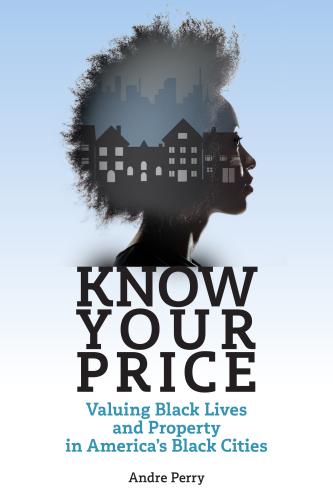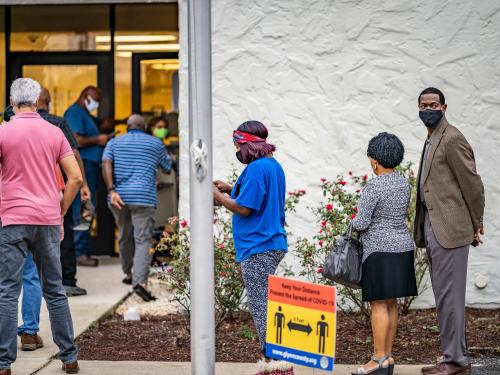In March, President Joe Biden introduced his $2 trillion American Jobs Plan, which endeavors to refurbish the country’s infrastructure and accelerate our economic recovery by putting people to work. Broad in scope, the plan addresses historic discrimination, climate change, broadband access, and labor rights—not to mention building and repairing roads and bridges.
Biden’s infrastructure proposal comes as experts struggle with a comprehensive workforce development strategy that prepares people without college degrees for the “future of work”—parlance that anticipates the potential impact of artificial intelligence and automation on jobs, skills, and wages.
To address those impacts, many have pushed for wider college degree attainment. While college degree attainment is important, it alone is not a sufficient guarantee of equitable outcomes, and can distract from deeper issues built into the labor market that nonprofit initiatives cannot fix.
This report focuses on the Philadelphia metropolitan area to show that even though college attainment is associated with boosted wages, racial disparities persist for Black workers at every level of education. Philadelphia is an important case study because of its stark divides between the knowledge economy sector concentrated in the Center City neighborhood and the vestiges of industrial and manufacturing power on the city’s edges.
Studying Philadelphia’s labor market demonstrates that the goal of increasing college attainment needs to be explicitly connected to efforts to close racial income gaps, including efforts to eliminate employment discrimination. Based on our review of the American Jobs Plan, we believe the proposal can help do that by creating well-paying federal jobs and spurring investment in marginalized communities, which can strengthen physical and social infrastructure and create a positive feedback loop that invites greater amounts of private sector investment and production.
By protecting and empowering workers in disenfranchised majority-Black and Latino or Hispanic neighborhoods, efforts to increase college attainment will become more effective in achieving the real goal: not simply a more educated labor pool, but middle-class wages for an increasing share of workers.
Philadelphia’s peripheral communities suffer from ongoing disinvestment
The future of work is one in which more jobs will require technical training or a college degree, as manufacturing jobs that once supplied middle-class wages are rapidly becoming automated or moved oversees. The American Jobs Plan represents a 10-year bridge that will provide families with a steady income while helping individuals build the skills they need to thrive in the future.
Infrastructure jobs offer economic and educational opportunities (through training) to people without a postsecondary degree. Low-wealth families—particularly those from historically marginalized groups—need these opportunities. Racism and place-based discrimination have not only robbed Black people of education and job opportunities, but also eroded the infrastructure where they live.
For instance, despite Philadelphia’s large number of colleges and universities, only 28% of its residents 25 years of age and older have a bachelor’s degree. In the Center City area—which has restaurants, colleges, and a thriving art scene—three out of four residents have college degrees. But in Philadelphia’s formal industrial hubs on the outer edges, where Black residents suffer from years of persistent economic disinvestment and intergenerational poverty, educational attainment rates are below 25%.
Philadelphia is increasingly stratified along lines of race, geography, and education. Left-behind neighborhoods such as Kensington (which is at the center of Philadelphia’s opioid crisis) have not received the same level of investment or support in transitioning to the knowledge economy. In 2017, 26% of city residents (almost 400,000 people) lived below the poverty line, according to the Pew Charitable Trusts. As that study notes, this degree of poverty is among the highest in any U.S. city, and has remained steady even as national rates of poverty have fallen. Philadelphia’s Latino or Hispanic and Black populations are disproportionately more likely to experience poverty, as depicted in Figure 1 below.

Meanwhile, Figure 2 shows that absent an intentional infusion of jobs from the American Jobs Plan, some of the largest occupation sectors for Philadelphia’s prime-age workers are skewed toward knowledge economy jobs in sectors such as management, health care, and education (highlighted in blue), and away from industrial economy jobs such as transportation, construction, and maintenance (in orange).

Without an equitable focus on raising wages, a college degree is not enough
The nonprofit Graduate! Philadelphia works to boost college attainment, particularly among Black and veteran Philadelphians. It offers workshops and events to provide residents with the information they need to continue in their education. The organization also partners with local colleges and universities, nonprofits, workplace agencies, and employers to help adults find pathways into employment.
While nonprofit sector collaboration is critical for building talent pipelines, it needs to be supported in ways that can respond to racial injustices in education and the labor market, with tangible investments that provide opportunities for high-paying jobs and improving material conditions.
Even with a college degree, Black workers’ wages in the Philadelphia metro area lag behind those of white workers. As our colleagues Martha Ross and Nicole Bateman have written, “Black and Latino or Hispanic workers earn less than white workers with equivalent educational levels and experience.” Structural racism pushes Black workers into lower-paying occupations, and their earnings in those occupations are lower than their white counterparts. As Figure 3 details, Black and Latino or Hispanic workers face a wage penalty at every point on the degree spectrum. These disparities are so jarring that the average Black worker with a college degree makes only slightly more than the average white worker without a degree. For bachelor’s degree holders, the premium for white workers is almost $25,000 in additional yearly income over Black and Latino or Hispanic workers.

Whether or not this reveals a systemic lack of wage parity in comparable jobs at individual firms, it is certainly the case that Philadelphia’s Black workers are locked out of high-growth occupations even with a bachelor’s degree. Our analysis finds that even with a degree, Black workers are overrepresented in service and support roles and underrepresented in managerial roles, as depicted in Figure 4.

Federal infrastructure investment and jobs can help close the racial earnings gap
A college education boosts wages for everyone, but as we have shown, college attainment alone will not close the racial income gap in cities like Philadelphia. Rather than believing the myth that the private sector will fix the market failures that it helped perpetuate, we need to embrace public investment as a pathway to more equitable outcomes.
While standard macroeconomic textbooks often warn that public investment can crowd out private investment, milestones such as the space race and, more recently, COVID-19 vaccine development have shown that public investment can also invite new investment and lead to the invention of new technologies. Biden’s call for the creation of innovation hubs at historically Black colleges and universities illustrates the vision for using public investment to spur economic growth by connecting resources to people and places that have not had as much access.
In addition to generating the positive externalities associated with public investment, the public sector can also help lessen disparities by providing federal jobs. The public sector has historically provided stable pathways into the middle class for Black Americans during periods in which private sector opportunities were limited due to racism. Today, one in five Black workers is employed in the public sector, according to the Center for American Progress. And because of robust labor union coverage, federal workers of color experience reduced racial resentment from their white coworkers, are protected from sexual harassment, and have higher wages.
Biden’s strategy of connecting expanded federal job opportunities to “greening” the economy can thus improve outcomes for workers and in the built environment. This can usher in even greater economic growth and invite even more private investment while ensuring climate resiliency, particularly for vulnerable communities.
Education, investment, and healing a rupture across Philadelphia
There are few American symbols as meaningful as the Liberty Bell, located in the heart of Philadelphia. Its inscription, taken from the King James Bible, is a stirring call to “Proclaim Liberty Throughout All the Land Unto All the Inhabitants thereof.” For the City of Brotherly Love, this call has particular resonance as a reminder of the need for solidarity among citizens who are equals before the law.
There is a rupture in Philadelphia rooted in geography, education, class, and race—a rupture that divides the places and people who are flourishing from those who have been abandoned. The drag of racism—coupled with a shameful lack of public investment—has led to stunted growth for marginalized communities as well as the economy at large. Even as Philadelphia’s Black workers pursue education, they still find themselves locked out of high-growth sectors and well-paying jobs. We cannot keep expecting college attainment or skill development to be a silver bullet when so many metropolitan and regional economies are structurally unsound in the allocation of resources and opportunities.
Instead of tinkering around the edges of the market by focusing exclusively on boosting college attainment, cities like Philadelphia need real investment in disadvantaged communities. The American Jobs Plan could ensure that investment, mend divisions, unleash new innovation, and boost outcomes for everyone.










Commentary
In Philadelphia, efforts to increase educational attainment must consider the racial earnings gap
April 27, 2021